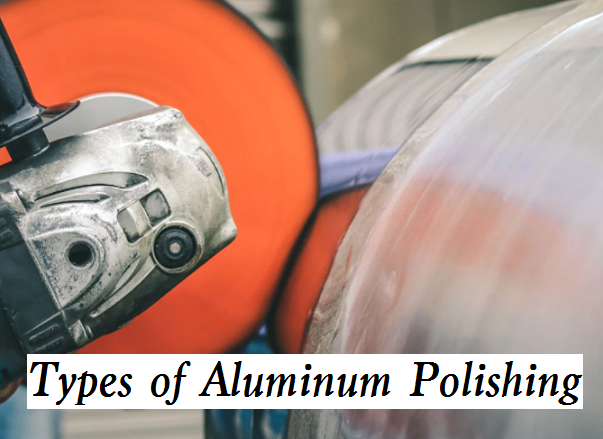Proper polishing can protect aluminum and aluminum products, prevent them from rusting and extend the service life. In this article, we are going to discuss why aluminum needs to be polished and three main types of aluminum polishing processes.

Why Is Aluminum Polished?
In the fabrication of aluminum products, anodizing is usually the last process to protect aluminum parts. Because ordinary aluminum alloys are easy to oxidize, although the oxide layer has a certain passivation effect, the oxide layer will peel off and lose its protection under long-term exposure. Therefore, anodizing uses its easy oxidation characteristics to control the formation of the oxide layer by chemical methods to prevent further oxidation of aluminum materials and increase the mechanical properties of its surface. However, before anodizing, it is necessary to determine whether the workpiece is defective. The main function of polishing is to remove burrs, scratches, corrosion spots, sand holes, air holes, and other surface defects on the surface of the workpiece, further removing the minor unevenness on the surface of the workpiece, so that it has a higher luster. In addition, the hardness of aluminum and its aluminum products is low, and the surface is vulnerable to mechanical damage during processing and forming, resulting in wear, scratches, and other surface defects. Moreover, aluminum products involve a wide range of industries and have different requirements on the surface of products. Surface polishing technology is an important means to obtain bright mirror surfaces, eliminate metal surface defects, beautify product appearance, ensure product quality and extend the service life of aluminum products. After polishing, the surface of aluminum alloy is smooth and smooth, and the decorative effect, light reflection, heat reflection, and corrosion resistance are improved accordingly.
Different Types of Aluminum Polishing Process
After the polishing wheel is added with polishing paste, the aluminum surface is polished on a high-speed rotating polishing machine. The friction between the high-speed rotating polishing wheel and the workpiece produces a high temperature, which makes the metal surface plastic deform, thus flattening the convex and concave points of the metal surface. At the same time, the extremely thin oxide film on the metal surface generated instantaneously under the oxidation of the surrounding atmosphere is repeatedly ground down, thus becoming more and more bright. At present, there are three main polishing processes for aluminum alloy surfaces.
1. Mechanical polishing
Mechanical polishing refers to the process of grinding between the high-speed rotating polishing wheel and the grinding stone of the part. During the grinding of the convex part of the aluminum product surface, there is metal slip, which is easy to form a thin layer of amorphous material on the surface to change the surface structure, thus reducing the roughness of the aluminum product surface and improving the surface brightness of the aluminum product. Generally, mechanical process means are suitable for the rough treatment of aluminum materials, which can remove oil stains, oxide skin, and burr on the surface of aluminum materials. It has the advantages of simple operation, eliminating streaks on the surface of aluminum products, and achieving a smooth surface. However, it needs a large investment, is complex equipment, is not suitable for polishing precision parts, is difficult to polish workpieces with complex shapes, consumes more abrasive materials, has corrosion resistance, and has poor brightness retention time. At present, mechanical polishing processes include manual polishing, automatic polishing, roller polishing, vibration machine polishing, rotary cylinder polishing, sandblasting, etc. Rotary cylinder polishing and vibration polishing technology is a new polishing process, which can make the surface of aluminum products reach good brightness.
2. Electropolishing
Electrolytic polishing is a polishing process that uses the interaction of electrolyte and DC power to treat the surface of aluminum alloy, also known as electrochemical polishing. The specific operation process is as follows: put the aluminum alloy into an electrolytic cell containing a special polishing electrolyte, and a passivation film will be formed on the aluminum alloy surface after the electrification reaction. After the aluminum ion diffuses rapidly through the film, resulting in a current density difference between the convex part of the aluminum alloy surface and the non-convex part of the surface, resulting in the dissolution rate of the convex part being greater than the non-convex part of the surface, so as to achieve the effect of leveling the surface. Conventional electrochemical polishing solution for aluminum is composed of phosphoric acid, sulfuric acid, and chromic acid, and the content of chromic acid is high, which causes great environmental pollution. In recent years, the polishing industry has made a lot of experimental research on the electrolytic polishing solution, and the electrolytic polishing solution without chromic acid has also been developed, which effectively solves the pollution problem. However, the device is complex (requires special fixtures), is greatly affected by electricity, and the cost is relatively high, so the scope of application is limited.
3. Chemical polishing
Chemical polishing is a surface treatment method to achieve the requirements of bright and mirror surfaces by virtue of the chemical solvent’s dissolution rate of the convex part of the surface of aluminum alloy being faster than the formation of the concave part. Chemical polishing is a very important polishing process for the surface treatment of aluminum products, especially for surface finishing. The chemical polishing process is the most common polishing process in the aluminum polishing industry due to its simple equipment, energy saving, low cost, and being suitable for workpieces with complex shapes. The aluminum products after chemical polishing have a good decorative effect, smooth surface, high heat reflection ability, enhanced corrosion resistance, and improved light reflection ability.

